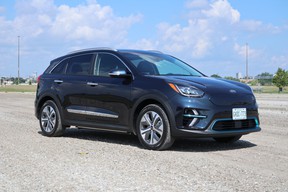Electric SUV Review: 2021 Kia Niro EV
It drives more like a conventional car, but completely fuel-free

Article content
In the automobile’s earliest days, electric cars could be as popular as gasoline ones. They didn’t have a lot of range, but there weren’t many roads anyway. Their big deal was that, unlike a gas car that had to be cranked, they were just get-in-and-go.
Advertisement
Article content
Once gas engines could start themselves, the electric car pretty much disappeared. But now it’s back and almost all auto manufacturers offer one or have one on the way, and at Kia, you can choose my tester, the 2021 Niro EV.
Along with all-electric, the Niro is also available as a gas-electric hybrid, or as a plug-in hybrid (PHEV) that can go about 42 km on its battery alone, before reverting to hybrid operation when that charge runs out.
Advertisement
Article content
The Niro EV’s officially-rated range is 385 km, and mine showed as high as 426 km when fully charged. As with any vehicle, exactly how far you get depends on several factors, including ambient temperature and how you drive. Battery vehicles are rated in Le/100 km, for litres equivalent — electric energy translated to a comparable amount of gasoline. The Niro EV comes in at 2.1 Le/100 km, a virtual match to rivals like the Chevrolet Bolt and Hyundai Kona Electric.
The three Niro trims start at $44,995 for the EX, and $50,695 for the EX Plus. My top-line SX Touring is $54,695. Unless you want your Niro painted black, you’ll have to add $250 for any other colour.
In all areas, it qualifies for the federal government’s $5,000 “green” rebate. In specific provinces, you can also add a provincial rebate of between $3,000 and $8,000.
Advertisement
Article content
The Niro powers its front wheels using an electric motor that makes 201 horsepower and 291 lb-ft of torque, with a single-speed transmission. Electric motors produce their peak torque immediately — unlike a gas engine, which needs to rev up — and the Niro is a peppy thing that more than holds its own in city traffic, or if you want to pass on the highway.
It drives like a conventional car, with smooth and accurate steering, and well-controlled cornering on curves — since its heavy 64-kW battery is under the floor, it has a low centre of gravity. The regenerative brakes put some power back into the battery whenever you slow down, and you can increase or decrease the level using wheel-mounted paddles. Combine them with the auto-hold function, and you can achieve “one-pedal” driving, where you use the throttle to accelerate, and then the paddles to slow and stop. But it takes practice and I found the novelty wore off quickly, and I went back to the brake pedal.
Advertisement
Article content
The Niro comes with a 7.2-kW onboard charger, and a DC fast-charge port is standard equipment. Most owners will likely install a Level 2 (240-volt) home charger, which is what you get at most public charging stations. On that, a full charge from a depleted battery takes about 9.5 hours.
Most owners charge at home, but for long trips they want fast-charge infrastructure, and that remains the Achilles’ heel for EVs. It’s growing, but still has a long way to go. I needed one that took credit cards, since I’m not signed up for a charging network, but not all do. It’s fine for charging companies to offer quick-pay apps as a loyalty program, but every station needs to accommodate casual users, just as gas stations do.
Advertisement
Article content
My local station had four fast chargers, but only one was fully operational and I had to wait for someone to finish using it. It was daylight and outside a large store, but a lot of them are pretty lonely at night, as writer Kristen Lee pointed out in a story. Just as with the earliest few-and-far-between gas stations, we’re along way from full convenience.
But those are issues with all electric cars, and getting back to the Niro, there’s a lot I really like about this little machine — especially its simplicity. So many EVs stick the equivalent of big-screen TV in the centre stack, requiring you to search for and tap an icon to do anything. Most of the Niro’s controls are conventional buttons and dials for the climate and other functions, and they’re easy to use, quick to find, and with little distraction. My complaint is the metallic accent strip bisecting the dash. It’s blinding when the sun hits it, and it’s very tiring to drive any distance with that in your eyes.
Advertisement
Article content
The comfortable front seats include plenty of legroom. The second-row chairs are okay if not spectacular for space, and the cargo area is generous. Features on the top-line trim include a sunroof, leather seats, premium stereo, and navigation, along with front and rear heated seats, cooled front seats, and heated steering wheel. Those use a lot of power, but if your butt and hands are comfortable, you’re more likely to turn down the cabin climate, which uses even more juice.
Electric cars aren’t for everyone, but then, neither are two-seater sports cars or one-ton pickups, and those are viable for many. If you’re looking at plug-in, look at the Niro. It’s a great little driver, so plug it into your test-drive list and see if it’s the one for you.











































